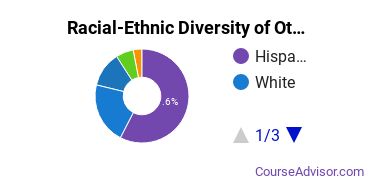Other Multi/Interdisciplinary Studies at Palo Verde College
Palo Verde College is located in Blythe, California and approximately 3,854 students attend the school each year.
Want to know more about the career opportunities in this field? Check out the Careers in Other Multi/Interdisciplinary Studies section at the bottom of this page.
Palo Verde College Other Multi/Interdisciplinary Studies Degrees Available
- Associate’s Degree in Other Interdisciplinary Studies
Palo Verde College Other Multi/Interdisciplinary Studies Rankings
Other Interdisciplinary Studies Student Demographics at Palo Verde College
Take a look at the following statistics related to the make-up of the other interdisciplinary studies majors at Palo Verde College.
Palo Verde College Other Multi/Interdisciplinary Studies Associate’s Program

Palo Verde College does a better job with serving racial-ethnic minorities than the typical school does. Its associate's program in other interdisciplinary studies graduates 22% more racial-ethnic minorities than the nationwide average.*
The following table and chart show the race/ethnicity for students who recently graduated from Palo Verde College with a associate's in other interdisciplinary studies.

| Race/Ethnicity | Number of Students |
|---|---|
| Asian | 3 |
| Black or African American | 3 |
| Hispanic or Latino | 17 |
| White | 14 |
| International Students | 0 |
| Other Races/Ethnicities | 3 |
Concentrations Within Other Multi/Interdisciplinary Studies
The following other interdisciplinary studies concentations are available at Palo Verde College. The table shows all degrees awarded in this field awarded for all degree levels at Palo Verde College. A concentration may not be available for your level.
| Concentration | Annual Degrees Awarded |
|---|---|
| Other Multi/Interdisciplinary Studies | 33 |
Related Majors
References
*The racial-ethnic minorities count is calculated by taking the total number of students and subtracting white students, international students, and students whose race/ethnicity was unknown. This number is then divided by the total number of students at the school to obtain the racial-ethnic minorities percentage.
More about our data sources and methodologies.
